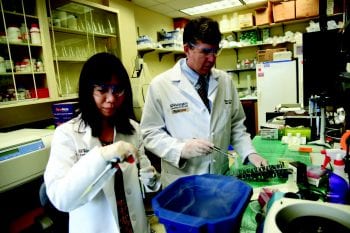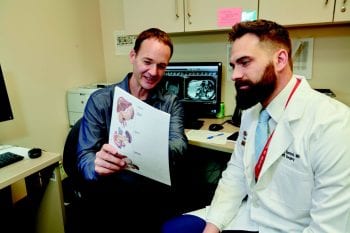Focus: Identify better pancreatic cancer treatments

A major grant to fuel pancreas cancer research is only two years in, but already meeting timetables to initiate clinical trials. Washington University’s Pancreas SPORE is designed to address the deadliest form of pancreatic cancer, pancreatic ductal adenocarcinoma (PDAC), by involving multiple departments, programs and institutions in interdisciplinary translational research. PDAC is so lethal — its five-year survival rate is 6 percent — largely because it spreads to other organs before symptoms appear.
Hepatobiliary-Pancreatic and Gastrointestinal (HPB-GI) Surgery Chief William Hawkins, MD, the Neidorff Family and Robert C. Packman Professor, is the SPORE’s principal investigator, leading a research team that includes medical, surgical and molecular oncologists; immunologists; pathologists; and pharmacologists at multiple institutions.
All four projects are progressing:
Surgical oncologist William Gillanders, MD, and immunologist Robert Schreiber, PhD, have already produced a personalized pancreas cancer vaccine administered post-surgery that is currently in a clinical trial. The idea is to stimulate an immune response to tumors after the pancreas cancer is surgically removed and its immunosuppressive effect is no longer present.
Another team is testing a CCR2/5 inhibitor that blocks immunosuppressive cells from reaching the tumor. A small molecule inhibitor of immuno-suppressive myeloid-derived suppressor cells combines with a checkpoint inhibitor and allows T-cells to recognize and kill the tumor. Washington University medical oncologist Kian Lim, MD, PhD, immunologist David DeNardo, PhD, and surgical oncologist David Linehan, MD, of the University of Rochester, lead the team.
Hawkins is developing a delivery platform for small-molecule drugs that sends a drug directly to tumors and avoids adverse side effects. His lab was selected to receive NCI assistance through a drug-development program called Stepping Stones. The program helped with chemistry that could lead to the development of a new oral chemotherapy drug.
The fourth project resulted in a trial of a MEK and ERK inhibitor of cancer pathways. A single drug worked to some degree, but the tumor compensated for the effect. Andrea Wang-Gillam, MD, a Washington University medical oncologist at Barnes-Jewish Hospital, and pharmacologist Channing Der, PhD, of the University of North Carolina, oversee the trial. The two are simultaneously investigating new drug combinations to circumvent compensatory pathways of tumor resistance to chemotherapy.
Says Hawkins about the SPORE funding, “A major grant like this allows developmental science to flourish.”
Highlights
The HPB fellowship has transitioned from a one-year to a two-year program. This change reflects the general trend toward offering more training in minimally invasive (MI) and laparoscopic surgery techniques. It supports the goal of Washington University to become one of the premier training programs for minimally invasive hepatobiliary surgeons. The MI training is under fellowship program associate director Chet Hammill, MD, MCR.
HPB-GI surgeon Ryan Fields, MD, has been appointed co-leader of the Solid Tumor Therapeutics Program at Siteman Cancer Center. Along with Joshua Rubin, MD, PhD, and Ramaswamy Govindan, MD, Fields will oversee the study of all solid tumors with the goal of improving treatment and expanding research programs. The role will combine the research and clinical efforts of Siteman Cancer Center, Barnes-Jewish Hospital and Washington University School of Medicine.
A novel “Tumor-on-a-Chip” technology is being used at Washington University to study the effect of different therapies and interactions between cancer cells and noncancerous components. The technology, which places a tumor in a micro-engineered system outside the body of a patient, allows for the accelerated study of tumor biology, treatment resistance and susceptibility without the time needed to grow the tumor in an animal model. The approach, used by Ryan Fields, MD, addresses the shortcomings of current cancer tumor models that include the lack of availability of non-cancerous blood vessels, immune cells, and connective tissues that are critical to tumor growth and treatment response.
